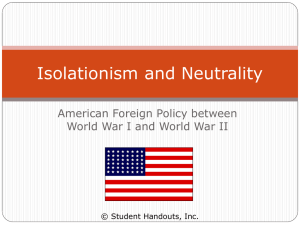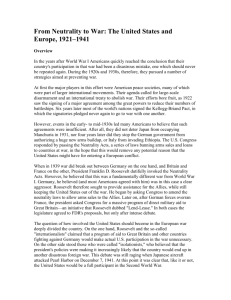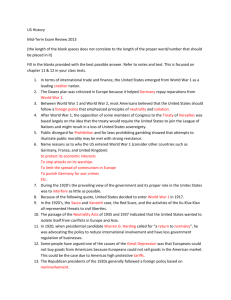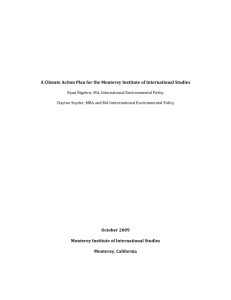Competitive Neutrality – Discussion Paper
advertisement
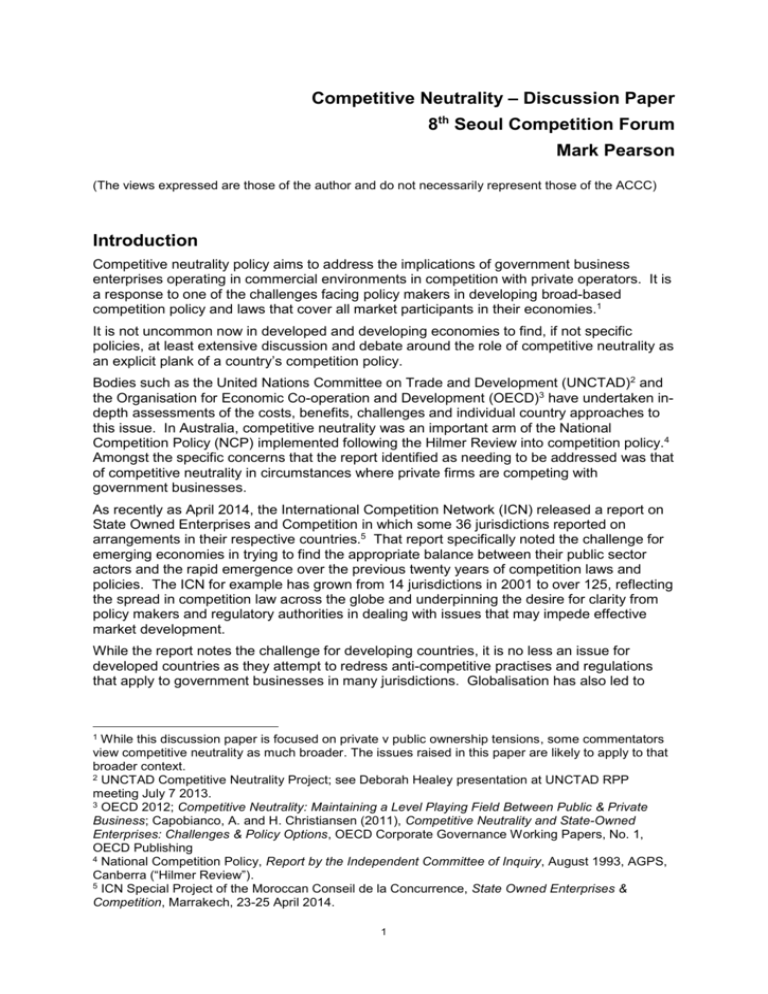
Competitive Neutrality – Discussion Paper 8th Seoul Competition Forum Mark Pearson (The views expressed are those of the author and do not necessarily represent those of the ACCC) Introduction Competitive neutrality policy aims to address the implications of government business enterprises operating in commercial environments in competition with private operators. It is a response to one of the challenges facing policy makers in developing broad-based competition policy and laws that cover all market participants in their economies.1 It is not uncommon now in developed and developing economies to find, if not specific policies, at least extensive discussion and debate around the role of competitive neutrality as an explicit plank of a country’s competition policy. Bodies such as the United Nations Committee on Trade and Development (UNCTAD)2 and the Organisation for Economic Co-operation and Development (OECD)3 have undertaken indepth assessments of the costs, benefits, challenges and individual country approaches to this issue. In Australia, competitive neutrality was an important arm of the National Competition Policy (NCP) implemented following the Hilmer Review into competition policy.4 Amongst the specific concerns that the report identified as needing to be addressed was that of competitive neutrality in circumstances where private firms are competing with government businesses. As recently as April 2014, the International Competition Network (ICN) released a report on State Owned Enterprises and Competition in which some 36 jurisdictions reported on arrangements in their respective countries.5 That report specifically noted the challenge for emerging economies in trying to find the appropriate balance between their public sector actors and the rapid emergence over the previous twenty years of competition laws and policies. The ICN for example has grown from 14 jurisdictions in 2001 to over 125, reflecting the spread in competition law across the globe and underpinning the desire for clarity from policy makers and regulatory authorities in dealing with issues that may impede effective market development. While the report notes the challenge for developing countries, it is no less an issue for developed countries as they attempt to redress anti-competitive practises and regulations that apply to government businesses in many jurisdictions. Globalisation has also led to 1 While this discussion paper is focused on private v public ownership tensions, some commentators view competitive neutrality as much broader. The issues raised in this paper are likely to apply to that broader context. 2 UNCTAD Competitive Neutrality Project; see Deborah Healey presentation at UNCTAD RPP meeting July 7 2013. 3 OECD 2012; Competitive Neutrality: Maintaining a Level Playing Field Between Public & Private Business; Capobianco, A. and H. Christiansen (2011), Competitive Neutrality and State-Owned Enterprises: Challenges & Policy Options, OECD Corporate Governance Working Papers, No. 1, OECD Publishing 4 National Competition Policy, Report by the Independent Committee of Inquiry, August 1993, AGPS, Canberra (“Hilmer Review”). 5 ICN Special Project of the Moroccan Conseil de la Concurrence, State Owned Enterprises & Competition, Marrakech, 23-25 April 2014. 1 renewed interest in the role of government business enterprises with the growth of actors in international markets that are linked directly or indirectly to their home governments. What is Competitive Neutrality? Competitive neutrality is, at its simplest, a policy that aims to provide for a level playing field for all commercial actors, whether they are government or private operators. Government businesses (or State Owned Enterprises as they are often referred to) may find themselves in an advantageous position due to their particular structures, laws, responsibilities and/or objectives. Competition policy and its accompanying legal framework should, to be effective, apply across the whole economy. Exemptions should be the exception, not the rule, to ensure the competitive process and its associated benefits are achieved.6 The Australian NCP7 was based on identifying and then, where possible and subject to a cost-benefit analysis, removing the legal, structural and/or regulatory barriers that acted to restrict competition to the detriment of the broader economy. The cost-benefit analysis allows recognition of community objectives that may lead to the acceptance of certain restrictions on competition for a greater, identifiable public benefit, but rigorous assessments must be undertaken to support these conclusions. Importantly, under Australia’s NCP, the onus lay with proponents of regulation to make out the public interest case for continued regulation, rather than on those proposing regulatory reform. The “default option” was the removal of regulatory restrictions on competition, not continuation of the status quo. Competitive neutrality is important, although not in itself sufficient, for ensuring an economy-wide application of competition law and successful implementation of competition policy more broadly. Where government businesses are significant market participants, appropriate measures for competitive neutrality become critical to the development of competition and achievement of efficiency goals. Various definitions have been advanced to provide clarity to the objective of competitive neutrality as a policy, but all reinforce the idea that a business involved in commercial activities should face the same set of legal rules, imposts, and disciplines no matter what their ownership status is. If government businesses are allowed to operate protected from market disciplines and pressures the end result is a distortion of the market and lower efficiency and associated productivity. The Australian Commonwealth Competitive Neutrality Policy Statement states that “(c)ompetitive neutrality requires that government business activities should not enjoy the net competitive advantages over their private sector competitors simply by virtue of the public sector ownership”. The summary document of the OECD’s 2009 Roundtable on State Owned Enterprises and Competitive Neutrality notes that “(c)competitive neutrality can be understood as a regulatory framework (i) within which public and private enterprises face the same set of rules and (ii) where no contact with the state brings competitive advantage to any market participant.” Inherent in these statements is the desire to ensure that distortions that arise through government ownership that effect resource allocations should be addressed to maintain the integrity of the markets the businesses operate in. At its most basic, the distortions are likely to arise through favourable cost advantages resulting from prices that are not reflective of the true cost of operating the business. Distortions can occur in production, consumption or Competition should generally “…lead to lower prices, increased output, greater choice and higher quality goods and services…more efficient use of resources when enterprises compete”, CUTS CCIER Briefing Paper, Competition Policy, Competition Law & Competitive Neutrality, 3/2013. 7 Australian Governments accepted the HiImer Review recommendations to: extend the reach of the Trade Practices Act; introduce third party access for nationally significant infrastructure; introduce competitive neutrality to restrict unfair advantages of GBE’s; restructure monopoly businesses to increase competition; review all laws restricting competition. 6 2 investment decision-making, with serious consequences for the market and impact on investment flows, private decision making in regard to business operations and consequent cost impacts on users of the products and service from those markets. Advantages of government ownership A number of advantages that accrue to government or state owned businesses are the result of history and legal structures. In many instances the advantages may well be the result of government failure to react to changes in the competitive landscape as these businesses move from their traditional areas into a competitive business environment, or as traditionally state provided goods and services come to be available from a broader range of sources. The advantages enjoyed by government businesses can include direct subsidies, regulatory advantages and favourable taxation or borrowing arrangements. Where a government business is involved in both competitive and non-competitive (regulated or monopoly) activities, cross subsidies and cost shifting between the subsidised and/or regulated parts of the entity’s business with the competitive parts can give rise to similar advantages. In some situations, it may be that the entity has specific information advantages or even shares assets with other government entities or departments. In the case of a monopoly provider, it could involve the use of the monopoly business to provide advantages to downstream or upstream operations that may well be operating in a competitive environment. These entities may be able to use their power in the regulated market to restrict entry into markets that are potentially competitive, but where they are able to bring their advantages to bear and leverage them to prevent or restrict competition in those upstream or downstream markets. Ancillary services also represent a market sector wherein competitive developments may be constrained to the advantage of the incumbent monopolist. Government owned businesses have often been granted immunity from a range of laws and regulations that private sector companies do not enjoy. These have included, and in some cases still do include, immunity from competition laws. These entities may not be subject to the same taxation regimes as their private competitors, which is fundamentally a subsidy to the operator. In the regulatory context, benefits can include regulatory holidays in addition to the above noted immunity from competition laws. There are a wide range of issues around the financing and structure of government businesses that can provide them with advantages over their private counterparts. These include: debt guarantees, both explicit and implicit; access to government interest rates, which are generally lower than those that private business may access; lack of requirements to adhere to normal financial and accounting practices, such as deprecation; and often no requirement to achieve what would be viewed as a normal return on investment. The lack of commercial drivers is often fundamental to government businesses enjoying a status removed from the usual competitive discipline of the market. These may include protection from bankruptcy and the lack of pressure from the market for corporate control in terms of takeover threats or threats to managers from commercially driven investors. This may alter or change the incentives of management and may undermine economic decision making with the resultant negative effect on production and consumption decisions and on resource allocation in the economy. 3 Disadvantages of government ownership While the focus of this discussion paper so far has been on the advantages that may arise from ownership by government, there are also potential disadvantages that logically arise from their social objectives and/or structures. These can include greater accountability obligations, universal service obligations, and requirements to comply with government wages and pension policies and even objectives around maximising or protecting employment in the particular sector.8 Industrial relations issues have often been raised as a disadvantage, in that the publicly owned enterprise may have to adhere to a different set of rules and regulations than would a private business. Government businesses may also be subject to procurement rules and processes that put them in a disadvantageous competitive position. A number of objectives may be imposed on government businesses by governments to achieve wider aims, including environmental, industrial policy and other social obligations.9 These can act to alter the focus of the business management from the more profit driven motives that generally underlie private sector businesses. Anti-competitive practises10 The lack of incentive to price efficiently is a likely outcome of incentive structures that reward revenue over profits. Businesses in this position may gain a competitive advantage on their private sector competitors that allow them to compete at prices that would not be supportable, especially over the long term, if full cost was reflected in the final product or service. Capobianco and Christiansen provide a “catalogue” of potential anti-competitive practices that may flow from the fact that a business is government owned. These include: the ability to raise rivals costs; price in a predatory fashion; raise barriers to entry; cross-subsidise; and make strategic use of inefficient technology to garner advantages from a lower marginal cost base. The risk is again with potential distortions in regard to consumption, production and investment, with a commensurate negative effect on allocative efficiency. It may also result in impeding innovation and dynamic efficiency in the effected market. Barriers to change Numerous commentators have noted the range of advantages, and at times disadvantages, which may arise through government ownership and involvement in commercial entities. At one level, support for government owned businesses may sit with the relationship between the political and departmental authorities acting as owners and the other stakeholders, such as business management and in some cases unions representing workers. These relationships have the potential to undermine the corporate discipline that one usually associates with private business operating in competitive markets. They may also act as an 8 Hilmer Review; p 297 op. cit. Competition in mixed markets: ensuring competitive neutrality A working paper, Office of Fair Trading July 2012 OFT1242 10 For an excellent discussion on this aspect of government run business (SOE’s) see Capobianco, A. and H. Christiansen (2011) op cit 9 4 impediment to reform, as there are likely to be implications for power structures and reward mechanisms flowing from reforms. The ability of a particular class of stakeholders or management to influence the makeup of boards, senior management and the strategic direction of the organisation to favour their own particular interests, will generally be reduced if not eliminated through policies aimed at ensuring amongst other policy objectives, competitive neutrality. Almost inevitably, whenever exiting structures are challenged potential losers will argue strongly for the continuation of the status quo. The ability to reward through patronage and nepotism and close links between management and owners can lead to decisions based on political imperatives rather than those of the market. The risk to effective operations becomes greater in models where the regulator and the owner have no clear separation. Especially in the delivery of monopoly services, we may see price and service quality impacted by structures that are not based on commercial drivers and therefore provide inputs into competitive markets that are of poor quality, not responsive to market needs (failure to innovate and lack of dynamic change) and/or are poorly priced to end users. This has a potentially negative effect on competitive markets that depend on those inputs and can seriously undermine market development in these sectors. In addition, clarity of objectives and transparency in regards to the Government/business interface is fundamental to providing assurance to the broader market that competitive neutrality principles are adhered to. Where policy dictates that businesses depart from competitive neutrality principles, transparency and clarity around those policies and government objectives will help ensure public service obligations of government businesses are clearly articulated and obvious to stakeholders. Competitive neutrality does not demand of government businesses that they cease to provide services for government or are otherwise responsive to government objectives. Community service obligations may still attach to businesses that may otherwise operate in, or provide other services to, competitive markets.11 One aim of a competitive neutrality policy is to provide transparency to the market to ensure that the business is not obtaining an undue advantage in its commercial activities through its government ownership or relationship. Where specific Government policies are mandated, appropriate governance and reporting provide transparency to the market. Measures such as accounting separation provide a level of guarantee that the government business is not cross subsiding or otherwise using its government ownership to the detriment of the competitive process. Another aspect of government business that is sometimes raised as a reason for lack of commitment to change, in light of competitive neutrality policy, is that the business in question may be an important source of revenue to the state. Protection of the revenue stream may override government commitment to opening up markets to greater competitive pressures. Addressing competitive neutrality concerns Structural change A range of reports and articles, some of which have been noted in this discussion paper, focus on issues of structure and governance as a starting point for addressing competitive neutrality concerns. These include privatisation and corporatisation, although it is by no means a necessary path to follow in order to achieve progress in addressing these concerns. However, consideration of structural changes may assist policy makers to consider the question as to what, if any, businesses Governments should remain in where markets are competitive. Even if Government decides to remain in these markets as an 11 For a discussion of these issues see “Hilmer Review”, Ch. 13, op. cit. 5 owner or shareholder, being forced to consider the competitiveness or otherwise of the markets in question may aid in developing appropriate transparency and reporting models. Privatisation and corporatisation policies aim to bring private sector objectives and associated incentives and drivers to the operation of the target business. In the case of privatisation, removal of government ownership entirely brings the entity directly into the competitive market place with its laws, regulations and rules around corporate behaviour, shareholder activity, management responsibilities and strategic planning. In the case of privatised natural monopoly assets, Australia governments took steps to separate the competitive parts of vertically integrated service providers such as utilities, while the natural monopoly parts were subject to direct regulation by an independent regulator. Effective corporatisation can provide for the business to be brought under a more market focused structure, while maintaining government ownership. The basic reasoning behind changes in the operational form of government businesses is to bring greater accountability and transparency, so that actions that may impede competition are made obvious to stakeholders. This includes transparency around the objectives that the Government owners may place on management, so that the market may more clearly understand the commercial responsibilities versus the social responsibilities and the impact on other commercial actors. In Australia, competitive neutrality became one of the arms of the much broader competition policy review referred to more generally as the Hilmer Review. The policy focused more broadly on moving towards greater reliance on market based mechanisms to discipline and drive performance. In turn, this led to welfare enhancement arising from greater efficiency and productivity, likely to be achieved through the promotion of competitiveness. In her presentation referred to earlier (the UNCTAD Competitive Neutrality Project), Deborah Healey notes that competitive neutrality policy was implemented in Australia against a broad backdrop of policy and incentives, and as such may not necessarily be appropriate for all jurisdictions. The Australian economy was in crisis with major productivity issues and rapidly faltering international competitiveness. The NCP included substantial Commonwealth payments as a reward to State governments for actions they agreed to undertake under the NCP banner. The Hilmer Review identified five basic principles for corporatisation that are repeated in the Commonwealth Competitive Policy Neutrality Statement.12 These include: clarity and consistency of objectives; clear management authority and accountability; performance monitoring; effective rewards and sanctions; and competitive neutrality. The OECD Guidelines on SOE’s has a similar list, although it notes the need for a strong, independent board and a clear separation of the state ownership from day-to-day operations. If regulated, there is also a need for the regulator to be independent of both government and the entity to ensure the integrity of decisions that may impact on that entity. Specific laws The European Union has had a long history of requiring adherence to competitive neutrality principles. Its State Aid rules and Transparency Directive, for example, provide strong direction to member states to provide full transparency and assessments in regard to State Aid and support of SOEs to ensure a “level playing field”. 12 Australian Treasury, Commonwealth Competitive Neutrality Policy Statement, June 1996, p 15. 6 It is also possible to identify and then act to reform specific legislation to address the source of concern directly. For example: immunity from competition laws can be withdrawn, deemed tax rates can be applied, and government businesses can be made subject to local planning rules and authorities. In some jurisdictions government businesses are subject to the same rate of return as competitive businesses. There is also a more extensive set of policies based around identification and recognition of the full economic cost attributable to the product or service being delivered. To be effective, policies such as these require the oversight, monitoring and/or enforcement of a skilled and appropriately resourced regulator. Transparency rules and accountability mechanisms around corporate governance should complement the regulatory oversight. Many jurisdictions have several levels of government. In Australia there are Commonwealth, State and local government entities reflecting national, regional and local arrangements. Decisions need to be made by policy makers as to how far competitive neutrality policies need to descend to be effective and for the benefits to outweigh the costs. As noted previously, Commonwealth government payments were provided to those Governments that effectively addressed anti-competitive elements of their jurisdictional legal and structural arrangements. Following its recent election, the new Australian Commonwealth Government has initiated a broad ranging review of competition policy.13 It is noteworthy that a number of submissions to the review have raised competitive neutrality concerns, especially in the context of local Government procurement and operations. The Australian competitive neutrality framework has no consequential penalties following a finding of breach of the rules. With the demise of Commonwealth payments to support strong state action, it has been argued that the framework may be lacking the strong enforcement underpinning needed to measure progress. On the other hand, as noted by Capobianco and Christiansen, Australian competitive neutrality policy has been recognised as being effective as “(1) it deepened reform of public enterprises in Australia; (2) it has been implemented by large government businesses, which led to significant efficiency gains; and (3) it substantially eliminated the advantages of government ownership”.14 Pricing Where it is not feasible to use structural solutions to address competitive neutrality concerns, ensuring that goods and services reflect true cost becomes an important objective. Pricing may be overseen by a regulatory agency or be part of a transparent audit program where accounting separation is enforced through high visibility accounts and reports. Where businesses undertake commercial activities and have shared assets, either within their own structure or with other parts of government, then cost allocation is essential in attempting to achieve competitive neutrality. This is especially so when the businesses have the ability to cross subsidies between the government-supported or subsidised aspects of their operations and those affecting commercial rivals. Full cost attribution helps to ensure that private operators are not disadvantaged due to the government owned businesses being able to internalise costs and to undertake its commercial activities subject to a lesser set of incentives than a private business. For example, the publicly owned and operated business may well have incentives that reward increased market share over profits. In that respect, competition may be reduced due to the 13 Competition Policy Review (the Harper Review); http://competitionpolicyreview.gov.au/issuespaper/submissions/ 14 Capobianco, A. and H. Christiansen, op. cit. 7 lack of that profit incentive, as the government enterprise prices at a level under what would be a normal competitive price. Policies that include full cost reflective pricing are likely to account for direct costs such as pensions, wages, accommodation and implicit costs in regard to taxes and other regulatory charges. They may also include debt, equity and commercial rate of return targets that are identified in financial targets and plans agreed by Minsters or responsible departments. Procurement As noted earlier in the paper, procurement rules can sometimes lead to government businesses being put at a disadvantage compared to private sector competitors. In the alternative, there has been substantial consideration given to the situation whereby the government business is actually advantaged in procurement processes due to its ownership and associated links. Procurement has attracted the attention off policy makers and regulators in the context of competitive neutrality, as outsourcing through tender processes has fundamentally altered the service delivery model in many traditional public sector markets. The situation in which a government business procures services in-house is especially problematic in terms of achieving efficient outcomes for taxpayers and the economy. Markets can be held back due to the inability of potential providers to gain a commercial foothold due to the advantages the government business is able to obtain. Incumbents may benefit from information, contacts and access to data that provides them with a competitive advantage unrelated to their own capabilities. A lack of openness and visibility may undermine the integrity of the procurement practices, leading to differences in treatment and/or opportunity based on ownership. Discrimination can often be overcome through stronger and enforceable rules and regulations based on transparent processes. Practical measures such as independent tender boards and probity advisors can provide significant confidence to participants, especially when competing with government entities that may well be advantaged based on implicit preferences that are unclear to the rest of the market. Departures from Competitive Neutrality Community service obligations (CSOs), or public service responsibilities, are often referenced as reasons for supporting decisions by government to move away from competitive neutrality principles. It is likely that where there are genuine CSOs, clarity around objectives of the businesses delivering the service and transparency in regards to pricing, reporting and accountability will provide significant assurance to the market as to the appropriateness or otherwise of delivery. Cross subsidisation for example should be able to be addressed, overcoming a major risk to competitive markets. Government run businesses have also been used as arms of industry policy in many countries. The notion of national champions is closely linked to arguments in support of allowing government business to continue to benefit from special advantages flowing form government ownership. This can be reflected domestically, through cushioning the domestic entity from competition from new entrants, and also internationally. The latter has become much more of a focus as countries develop strong export oriented businesses that operate either directly or indirectly under the auspices of the home market government. Government businesses often play a fundamental role in developing economies, having special rights in regard to protection from rules and regulations that private companies would normally be required to observe. There are risks that countries may use their government businesses to further broader industry policy objectives and to provide such things as 8 concessionary finance, finance guarantees or regulatory holidays. If investments into international markets are not based on commercial economic factors then distortions are likely to occur as the government supported business crowds out other private competitors. Role of governance A significant number of jurisdictions have taken steps to ensure that government businesses are subject to competition laws and address other aspects of competitive neutrality (see the ICN Report referenced in the introduction). Given the obvious disparity between countries in their stages of development, especially in regard to the maturity of their competition law, differences undoubtedly exist between countries. The reports noted in this discussion paper point to significant work undertaken and underway to identify and address concerns where the risk of market distortions and negative impacts on economic welfare are likely. UNCTAD, for example, has recently published a report that notes many if not all respondents to the Competitive Neutrality Project are at some major stage of reform through corporatisation. This has followed a significant process of privatisation, especially in developed economies. In line with these processes, there is often a commitment to improved governance consistent with that found in private sector corporates. Public audit processes and more professional and independent Boards of Directors are examples of policies being implemented to build confidence in the operation of state businesses. These measures provide some level of assurance to potential and actual competitors that they will not be disadvantaged in the markets in which they may compete. Governance includes independent Boards with experienced, professional directors; Government ownership separate from the day-to-day operations of the business; clarity of objectives, both commercial and where appropriate non-commercial (or social); commercial audit processes; and performance and financial reporting requirements that are enforced and adhered to. Norway, for example, has no specific competitive neutrality policy but does have in place a set of practices around corporate governance which include equal treatment of shareholders, transparency, and a focus on the board, its exercise of control and independence.15 The OECD’s 2005 Guidelines on Corporate Governance of State-owned Enterprises are often quoted in discussions of governance and its role in addressing issues of competitive neutrality. These guidelines advocate for a strong governance framework rooted in transparency, performance reporting and clarity around roles and objectives with clear lines of separation and responsibilities between management, Boards and Government ownership. Conclusion Policy makers have long been concerned with the potential for government businesses (or State Owned Enterprises) to distort otherwise competitive markets, due to benefits obtained through government ownership and/or specific regulatory and legal immunities. A substantial amount of work has been undertaken across a range of countries and organisations to identify the challenges and provide a path to reform and to additional lines of research that could be undertaken. Advantages of government ownership could include credit finance, overt support from government departments in regard to information and policy support, immunity from taxes and competition laws, protection from bankruptcy and lack of requirements to meet audit and 15 Competition in mixed markets: ensuring competitive neutrality; A working paper, Office of Fair Trading, July 2010, p 34. 9 other statutory accounting requirements. Disadvantages can come in the form of community or public service obligations, pressure to meet government requirements in regard to strategic decision making and management roles, and pressure to support government policies that may impede usual commercial operating practises. Substantial work has already been undertaken to address issues arising from government ownership that may lead to distortions in the market and reduce the welfare of citizens. However, there are a number of areas, especially in regards to government businesses operating in international markets, where private business is concerned at the potential for government support to undermine the competitiveness of private sector companies operating in the same environment. 10


